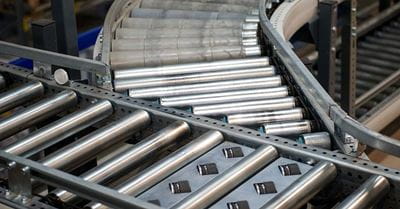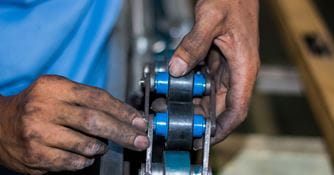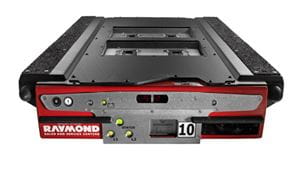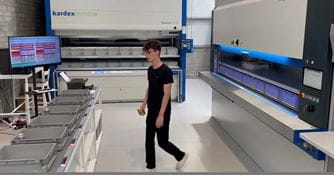Sortation Systems | Calexico

Raymond West supplies a full range of conveyor and automation products, including all types of sortation solutions.
To speak with an automation expert, phone us at (760) 768-8700.
Are you considering a sortation solution for your Calexico warehouse, distribution center or production facility? The most common kinds of sortation systems vary widely in capability and expense. In this article we offer a high level outline of the advantages and shortcomings of the most popular kinds of sortation equipment.
Cross-Belt Sorter & Tilt Tray Sorter
Tilt-tray and cross-belt sorters provide similar functionality and are frequently associated when covering sortation mechanization. However, they are quite different solutions.
Tilt-tray sorters are a series of trays attached to carts that are carried on a continuous-loop conveyor. Items are put into the trays at one or more induction points on the loop through manual or automatic processes. When a product reaches its sorting destination, the tray that is transporting it tilts and transfers the item toward a chute.
Cross-belt sorters are motorized belt conveyors mounted to carts operating on a continuous conveyor loop. Comparable to tilt-trays, cross-belt sorters drop materials onto a chute when they reach the appropriate sorting destination.
Advantages: Cross-belt and tilt-tray sorters offer the best sorting rate and can manage a variety of product types as opposed to other sortation solutions. They are a terrific option for operations that deal with a wide array of SKUs. These types of systems are likewise reasonably quiet and permit a more comfortable workplace for warehouse personnel.
Disadvantages: The speed, capability and versatility or these sorters come at a price-- they are among the most costly sortation solutions available.
Shoe Sorter
Sliding shoe sorters utilize a "shoe" system attached to the conveyor surface that nudges and diverts materials onto an alternate, after-sort conveyor. Shoe sorter systems are fed by a single flow of products that may be a combined feed from several upstream areas of a facility. These kinds of sortation solutions are extensively utilized in shipping applications.
Advantages: Sliding shoe sorter equipment setups can accommodate a reasonably high peak rate, sometimes several hundred products per minute, depending upon the product weight and size. Additionally, a wide range of products can be processed because of the simplicity and flexibility of a positive divert system.
Disadvantages: Shoe sorters are more costly than other alternatives like pop-up wheel sorters. Likewise, divert centers are not readily movable, making the system complicated and costly to modify. These systems also create more noise than tray or belt solutions and are accordingly not as worker compatible as other kinds of sorters.
Pop-up Wheel Sorter
Pop-up wheel sorters are a popular alternative because they are relatively affordable and easy to install. Wheels or rollers are integrated with a belt conveyor. When a product must be diverted, the wheels quickly rise up to divert items at an angle to a secondary, downstream conveyor.
Advantages: Pop-up wheel sorters are modular, so components can be rapidly added or removed when the system requires modification. These systems can also be substantially less expensive than other sorter types.
Disadvantages: These types of sorters deliver quite a bit less performance and capacity than shoe, cross-belt or tilt-tray options. They will undeniably increase efficiency, yet might not maximize throughput like other options. Since pop-up systems don't provide a positive divert, the kinds of products they can process are reduced.
Automated Sortation Systems Near Me
To get more guidance on sortation options, call an automation specialist at Raymond West Inc today!
Raymond West's Calexico facility serves Imperial County and Yuma County, Including Calexico, Brawley, El Centro, San Luis, Yuma and surrounding areas.
Raymond West | Calexico Material Handling Equipment Supplier
285 Rood Rd
Calexico, CA 92231
(760) 768-8700
You May Also Like:

Conveyor Repair | Calexico
Raymond West is a Calexico warehouse automation equipment supplier. We offer repair and service for many types of conveyor systems. Call us today at (760) 768-8700.
Learn More

Order Picking Systems | Calexico
We design, install and maintain state-of-the-art order picking solutions for all types of warehouse and distribution center operators.
Learn More

Pallet Shuttles
We supply a full range of warehouse automation equipment including pallet shuttle systems. If you'd like to find out more about automation possibilities for your warehouse, give us a call today.
Learn More

Pick To Light Solutions | Calexico
Pick to light systems are efficient, high throughput systems that can transform your warehouse and increase profitability.
Learn More

